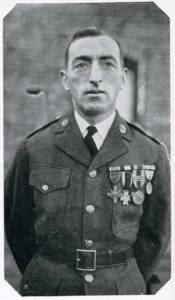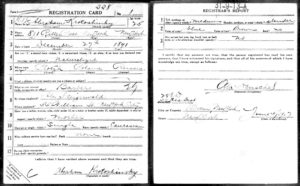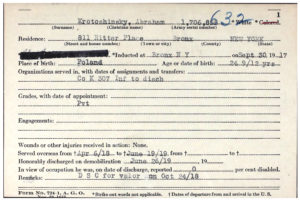My prior post, Measures of Valor: American Jewish Military Service in World War One – Part One, focused on the absence of a substantive historical record of the military service of American Jews during the First World War, with a specific eye towards the creation of the American Jewish Committee’s 1919 pamphlet, The War Record of American Jews. I also mused about the reasons why – unlike in Europe – no substantive book (or, books) covering the military service of American Jewish soldiers in WW I was ever created.
And, this post?
It’s an illustration (in words and images) of how The War Record of American Jews was presented in the Jewish press; in this case, in The Jewish Exponent of February 28, 1919, through which the “core” of the AJC’s pamphlet was brought before the public in newspaper format.
And, to a lesser extent, this post is an exploration of the pamphlet’s actual content.
To that end, the entirety of the Exponent’s text is presented below, the “original” in Times New Roman font and my own comments in Arial font. The original item being nearly one and a half pages long, it’s pretty substantial even by the size of the newsprint font used in 1919, and undisputably gargantuan by the standards of newspapers now, in 2020.
The names of all 128 soldiers listed in the AJC pamphlet – all of whom were cited in official correspondence, or, who received military awards associated with such citations – appear in the Exponent’s article. However, the Exponent’s editors left out out the few lengthy sections of descriptive text that variously appear in The War Record of American Jews, for example for DSC winner Abraham Krotoshinsky of “The Lost Battalion“, and some other soldiers. Otherwise, for this post, I’ve added commentary, images, links, and – where needed – corrections. My own comments are taken from information I’ve accumulated in an endeavor to identify all American Jewish military casualties of WW I, which I mentioned in the previous post.
Oh… Be prepared for a measure of scrolling. (Just sayin’.)
Next post? The War Record of American Jews, in the “next” war – the Second World War.
________________________________________
American Jews Have Glorious War Record
The Jewish Exponent
February 28, 1919
REMARKABLE DATA ISSUED BY AMERICAN JEWISH COMMITTEE
[FIRST REPORT OF OFFICE OF WAR RECORDS, AMERICAN JEWISH COMMITTEE]
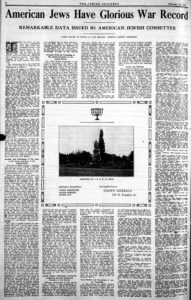
 That the Jews of America have contributed more than their proportionate quota to the armed forces of the United States in the war is shown in the official “War Record of American Jews”, which has just been issued by the American Jewish Committee, through its Office of War Records, at 31 Union Square, New York City.
That the Jews of America have contributed more than their proportionate quota to the armed forces of the United States in the war is shown in the official “War Record of American Jews”, which has just been issued by the American Jewish Committee, through its Office of War Records, at 31 Union Square, New York City.
The outstanding facts developed by the course of the inquiry to date may be summarized as follows:
(1) The total number of individual records collected to December 31, 1918, is well in excess of 100,000. Many of these records have been forwarded directly from the camps and trenches by the soldiers themselves. Others have been sent in by their friends and relatives, by agents of the Jewish Welfare Board at the camps, or by local branches of the Board. The great bulk of the material, however, has been obtained through the unstinted co-operation of the Rabbis of the country and through the leading Jewish organizations, national, fraternal, and local.
(2) Of the 100,000 records at hand about 80,000 have been tabulated and classified. The exact figures as to the distributions of these men, according to the branches of the service, rank, states and cities of origin, etc., will be found in the appended tables. Briefly, they show that of the 80,000 men whose records have been tabulated, about 69,000 are in the Army, 8800 in the Navy, 1700 in the Marine Corps.
Of the 69,000 Army records, 12,458 are known to be in the infantry, 4,751 in the Artillery, 4,438 in the Medical Corps, 2,866 in the Signal and Aviation Corps, 1,373 in the Engineer Corps, 877 in the Cavalry, 735 in Ordnance, and 1,472 in other branches. Men whose branches of service are as yet unknown, but the greatest majority of whom will probably be found in the Infantry, number 29,969.
As the rank, there are so far recorded 5,162 Jewish commissioned officers in the Army, of whom 24 are Colonels, 202 Majors, 782 Captains and 4,007 Lieutenants. In the Navy there are 206 commissioned officers, including one Rear Admiral, and in the Marine Corps 40 Commissioned Officers, including one Brigadier-General.
As to States and Cities of origin: – The largest centers of Jewish population have, of course, supplied the greatest number of Jews in the service. New York State and city, have supplied more than one-third, the total for the state being 26,866, of which 22,210 are from New York City. Pennsylvania follows with 9,643 of which 7,098 are from Philadelphia. Illinois is credited with 3,459, of which 2,670 are from Chicago, and Massachusetts with 3,377, of which 830 are from Boston. Other states will be found pro-rated accordingly. The class “States not known” comprises 15,685 of which probably ___ty per cent will ultimately be traceable to New York.
As the full significance of these figures may be grasped only in their relation to certain questions that are, of necessity, uppermost in the minds of those interested in this subject it may be well to present the information developed so far in the course of the inquiry directly in the form of questions and answers – it being understood, however, that as these figures are not final any deductions drawn from them must also lack finality.
Number and Percentage of the Jews
in the Army and Navy of the
United States
The best available evidence indicates that there are from 150,000 to 200,000 Jews in the Service, or from four to five per cent of the total forces of the United States, which at this date number approximately four million.
These estimates are based upon two independent calculations which tend strongly to confirm one another. One is a study of the Casualty Lists. The total number of casualties in the American Expeditionary Forces to November 1, 1918, was 64,157. The total number of Jewish casualties noted to that date was 2,502 or 3.9 per cent of the total. If the Jewish casualties are not excessive and there is no reason to assume that they are (at least for the earlier period of American participation; the later fighting in which the 77th, Camp Upton Division, was engaged, will probably raise the proportions, this would indicate that the Jews constitute about four per cent of the Army and Marine Corps. As these two arms of the service at present number about 3,700,000 men this would make the total of Jewish soldiers and Marines about 145,000; and as the same ratio probably applies to the Navy, its present personnel of 500,000 would furnish approximately 20,000 Jews. The total for all branches of the services would therefore, by this method of calculation, approximate 165,000.
The other possible method of estimating the total is based upon observations made in the process of collecting the records of the Marine Corps. It may be assumed as axiomatic that in order to secure entirely complete lists of the Jews in the service it will be necessary to combine a search of the official records at Washington together with the collection of extra official records from purely Jewish sources. In practice it has been found possible to make this thorough search in only one office in Washington, that of the Adjutant and Inspector of the Marine Corps. By comparing the results obtained by the use of both methods of search it was found that the unofficial methods of search would have furnished only 532 names, while the official search furnished 1,172 names or approximately twice as many. As the 80,000 names at present classified were practically all obtained from unofficial sources, this would indicate that we have at present only one-third of the total of all Jews now in the service. On the basis of this estimate the aggregate should be nearly 250,000. It is obvious, however, that this is an over-estimate, due to the fact that the Marine Corps is not a typical corps, concentrated for training purposes in large cantonments, where they can easily be checked up and reported by agents of the Jewish Welfare Board or by the local Jewish papers, as in most camps. In other words, the unofficial method of search is somewhat more defective in the case of the Marines than in most branches of the service. But even if a full discount of twenty or twenty-five per cent be written off for this one factor there would remain an approximate total of 200,000 Jews in the service, according to this estimate. It is probably safe to infer, therefore, that the final figures will be found somewhere between the minimum of 150,000 indicated by the first method of calculation, and the maximum of 200,00 indicated by the second method.
Percentage of Jews in the Service
The entire Jewish population of the country, according to the latest estimates, is about three per cent of the total population. The Jews in the military and naval forces of the United States , however, constitute from four to five per cent. On the face of these figures it would seem that the Jews of America have contributed more than their share to the armed strength of the United States. There is reason to believe, however, that the final figures, when available, will demonstrate that the Jewish contribution has been ever greater than this. It is well known that the selective service system has operated more effectively in the North and East than in the South and West, and in the urban than in the rural districts – that is, in the large centres of population, which happen also to be the centres of Jewish population. Moreover, the number of industrial exemptions has been greatest in agriculture, mining and the metal industries, where the Jews are least extensively employed. It has therefore developed, as an unavoidable and incidental feature of the draft system, that the Jewish elements of the population have perhaps been drawn upon more heavily, in proportion to their numbers, than any other elements.
But the principal reason for the high percentage of Jews in the armed service rests elsewhere. It is to be found in the remarkable number of Jewish volunteers. The evidence as to this is definite and conclusive. The great majority of the records in our files state the exact ages of the men reported. By actual count is has been ascertained that of all the men whose ages were known fully ten per cent were well outside the draft ages at the time that the count was made – before the registration of September 12. If, in addition to this number there be added the 10,536 sailors and marines who are all volunteers, the total of such volunteers at present recorded rises to more than twenty per cent of the total in our files. Should this ratio represent fairly the proportion of Jewish volunteers in all the arms of the service, and at present there is no reason to believe otherwise – this would indicated that there are from 30,000 to 40,000 Jewish volunteers in the service today. In other words, the normal Jewish quota of three per cent, seems to have been contributed through the draft, and the excess to have been supplied by volunteers.
Jewish Soldiers Distributed Among the
Combatant and Non-Combatant
Branches of the Service
Although distinctions of this nature have become, in the organization of modern warfare, almost meaningless, and are therefore not to be over-emphasized, certain comparisons that have been noted in this connection are so striking as to compel instant attention.
According to the latest official figures available as to the strength of the army as a whole and of each of its component branches, the total strength was, in November, 1918, about 3,700,000, of which Infantry, Artillery, Cavalry, Engineers and Signal Aviation branches together constituted 60 per cent, and the other branches, such as Ordnance, Quartermaster, etc., constituted 40 per cent. But among the 80,000 army records in our possession the distribution among the first named branches is fully 72 per cent, or 12 per cent greater than in the entire army. The infantry branch constitutes 26.6 per cent of the entire army, while of the Jewish total it constitutes 51.7 per cent. Artillery is 14 per cent of the U.S. Army, 10 per cent of the Jewish total. In Cavalry the rate for the entire army is 2 per cent, for the Jews only 1 per cent. The Engineer Corps constitute 11 per cent of the army strength, and but 3 per cent among the Jewish records. The Signal and Aviation Corps represent 7 per cent of the United States total, and 6 per cent of the Jewish total. The Medical Corps is 8 per cent of the army total, 9 per cent of the Jewish total. The Quartermaster Corps is 6.2 per cent of the army total, 5.1 per cent of the Jewish total. Ordnance is 1.7 per cent of the army total, 1.5 per cent of the Jewish total.
If, therefore, such distributions are still held valid it may be said truthfully that the relative proportion of Jews in the combatant branches is far greater than in the non-combatant branches.
If additional evidence as to this point is desired it may be found in a comparative study of two branches of the service differing so widely in their functions as the Quartermaster Corps and the Marine Corps. In view of the fact that the Quartermaster Corps is essentially the business organization of the army, and that the Jewish recruits, as a class, undoubtedly possess greater business training and greater capacity for organization than their non-Jewish comrades, it may reasonably have been expected that this branch of the service would possess a far higher percentage of Jews than all other branches. The evidence at hand, however, points definitely to the contrary. While the personnel in the Q.M.C. constitutes 6.2 per cent of the army as a whole, it constitutes only 5.1 per cent of the Jewish total.
The Marine Corps, on the other hand, is essentially a fighting organization. Every man in this corps is a volunteer, enlisted with the full knowledge that the corps would be sent wherever the fighting was thickest. Now of the 60,000 Marine Corps records examined to date about 1,700, or three per cent, proved to be Jewish, while probably an additional 200 were Jewish, but not definitely traceable by our methods. And of these 1,700 Jewish Marines, fully thirty per cent joined immediately after June 5, the day when it was published to the world that the Marines were the American “shock troops” at Chateau-Thierry.
Total Number and Percentage of Jewish Casualties
At this writing the official casualty lists are still far from complete, and it is therefore impossible to state, with any assurance of accuracy, the total number of Jewish casualties. A reasonable conservative estimate, however, would place the total deaths from all causes at about 2,500 (of which about 1,500 were killed in action or died of wounds) and the total number of all Jewish casualties of every description at about 10,000.
The total number recorded to November, 1918, is 2,502 or 3.9 per cent of the total in the Army and Marine Corps. Of these 451 were killed in action and 142 died from wounds, 96 died from disease, 73 died from accidents and other causes. The total number of deaths is 882, or 4.1 per cent of the total in the American Expeditionary Forces. The total number of wounded is 1,397, or 3.8 per cent of the American forces.
Honor and Citations
The report of citations for gallantry in action, and of other honors and decorations, are too belated to provide sufficient data for the purpose of the present report. It is known, however, that the number of Jewish soldiers who have received American and French decorations is considerable. It was the 77th (Upton) Division – largely Jewish – that was in the thick of the fighting at Argonne Forest and it was practically a Jewish battalion – belonging to the famous 308th – that distinguished itself for extraordinary valor in the Argonne. The list of all citations will therefore be prepared for publication as soon as sufficient information with respect to these honors shall be available. In the meantime the following tentative list of official citations noted to date, although manifestly incomplete, will serve to give an idea of the valor of the Jewish soldiers in action.
Adler, Julius O., Major, 306th Infantry. – “During the relief on the night of August 11-12, 1918, the 2nd Battalion, 306th Infantry, suddenly came under heavy shell fire of the enemy and the companies were ordered to dig in. This officer showed coolness, special devotion, and care of his men, calmly walking up and down in front of the men, preventing panic, and indicating to individual men where best to seek shelter, and preventing bunching and grouping. During this critical time this officer gave little thought to personal danger, and his action undoubtedly reduced the number of casualties suffered by the battalion.”
Aperstein, Sam, Company D, 302nd Engineers. – Cited November 3, 1918, for gallant and meritorious conduct in the course of bridge building operations across the Vesle north of Villesavoye, while exposed to heavy shell fire for a period of three and one half hours.
Aronson, Joe, United States Marines. – Aworded Croix de Guerre, after having suffered a leg wound in the fighting around Chateau Thierry.
Asher, David L., 103rd Infantry. – Cited for bravery.
Baer, Clarence A., of Detroit, Mich. – First American to receive medal of the Raconaisance France.
Baer, Sanford, Lietenant, of Murphyboro, Ill. – Awarded the Croix de Guerre for bravery in action. The award was made in the hospital.
Belson, Samuel L., Boston, Massachusetts, 104th Infantry. – Entire regiment cited.
Bemonwski, Joseph G., 104th Infantry. – Cited for Bravery.
Benjamin, William, Sergeant of Portland, Oregon. – Awarded Distinguished Service Cross for extraordinary heroism in action at Chateau Diable, near Fiammes, on August 27.
Berg, Joseph, Company G, 167th Infantry. – Distinguished Service Medal for extraordinary heroism in action near Croix Rouge Farm, northeast of Chateau Thierry, on July 27.
Bergman, Axel H., First Class Private, Company E, 302nd Engineers. – Cited November 3, 1918, for gallant and meritorious conduct in the course of bridge building operations across the Vesle north of Villesavoye, while exposed to heavy shell fire for a period of three and one half hours.
Bergstein, Alfred N., First Lieutenant, Medical Corps, 18th Infantry. – For extraordinary heroism in action near Exermont, France October 8, 1918. Under heavy shell fire, Lieut. Bergstein cared for the wounded, although he had been severely wounded and was suffering great pain. He refused to be evacuated until all the wounded had been treated. Home address, Samuel Bergstein, 624 Minersville Street, Pottsville, Pa.
Bergman, Raymond, Second Lieutenant, 306th Infantry. – “Throughout the advance through the Argonne Forest made by G and E companies, 306th Infantry, under intense enemy artillery and machine-gun fire, this officer displayed extraordinary courage and devotion to duty.”
Bernheimer, Louis G., First Lieutenant, Air Service, pilot, 88th Aero Squadron. “For the following act of extraordinary heroism in action near Tailley, France, November 2, 1918: Lieutenant Bernheimer and First Lieutenant Ralph P. Bagby, observer, on their own initiative went on a reconnaissance mission, flying fifteen kilometers behind the German lines, securing valuable information on the condition of the bridges across the Meuse River and enemy activity in the back areas and harassing enemy troops.” Home address, Sidney Bernheimer, father, 138 East Seventy-second Street, New York City.”
Bernstein, Isidore H., 5 West 111th Street, New York City, 104th Infantry. – Entire regiment cited.
Bloch, Harry, Worcester, Massachusetts, 104th Infantry. – Entire regiment cited.
Block, Raymond A., Newark, New Jersey, 104th Infantry – Entire regiment cited.
Block, Samuel M., Private, Company A, 102nd Infantry. – Distinguished Service Cross for extraordinary heroism in action at Marcheville, France, September 26, 1918. After several other runners had failed, Private Block volunteered and was successful in carrying a message through an intense machine-gun and artillery barrage.
Blohm, John, Sergeant, Company B, 305th Infantry. “On September was a member of a patrol operating in daylight out of St. Thibaut across the Vesle River to Bazoches, which patrol, having accomplished its mission, was returning to our lines. Due to heavy fire the patrol had taken refuge in shell holes. Sergeant Blohm saw Corporal Catalina, Co. C, 305th Infantry, a member of this patrol, dragging himself through the grass toward the river and bleeding profusely from a wound in the back. Sergeant Blohm left his cover, carried the wounded Corporal to shelter behind a tree near the river bank, and there bound his wounds. He then slipped into the river and with the assistance of the boughs of a tree fallen from the opposite bank drew Catalina after him to the south side of the river. He then carried him across the open some 200 yards to our outpost line. During this action the enemy fire had been continuous, both rifle and machine-gun.
Blomberg, Henry S., First Lieutenant, 127th Infantry. – Distinguished Service Cross for extraordinary heroism in action near Juvigny north of Soissons, France, August 30, 1918.
Bloomberg, Louis, 2426 East 59th Street, Cleveland, Ohio. Cited for bravery in the Battle of the Marne.
Blum, Harvey H., Sergeant, 37 MM Cannon Platoon, Headquarters Co., 307th Infantry. – “During the advance in the Argonne Forest, from September 25 to October 16, 1918, was continually with the advance line despite the fact that the several sections of his platoon periodically relieved one another, and on several occasions he did display great bravery and coolness under fire.”
______________________________
Brown, Henry, Lieutenant, of Detroit, Mich. – Won distinction in the service in different ways. In his service under fire he was repeatedly cited for bravery. He died in France, October 29, twelve days before the end of the war.
A Second Lieutenant in K Company, 118th Infantry Regiment, 30th Infantry Division, he was actually killed in action on 11 October. The son of Charles H. (3/11/59-11/6/90) and Pauline (Robinson) Brown (later Rose) (3/10/66-5/23/46) and brother of Edith, of 115 West Euclid Ave., Detroit, he was born in that city on January 7, 1888. Henry is buried at the Somme American Cemetery, in Bony, France, at Plot A, Row 28, Grave 12. A memorial cenotaph was erected in his memory at Woodmere Cemetery, Detroit. His name appears on page 73, Volume 2, of Soldiers of the Great War.
______________________________
Calmen, B., 104th Infantry. – Entire regiment cited.
Cohen, Abraham, 103rd Infantry. – Cited for bravery.
Cohen, David, of Battery F, 65th Coast Artillery Corps. – Awarded the Croix de Guerre.
Cohen, David, Worcester, Mass., 104th Infantry. – Entire regiment cited.
Cohen, Meyer, Webster, Mass., 104th Infantry. – Entire regiment cited.
______________________________
Cohen, Simon L. Bloch, Sergeant, Philadelphia, Pa., Company B, 1st Prov. M.G. Battalion. – Decorated while in hospital with Croix de Guerre by Marshall Foch.
You can read Simon’s sad story at Amy B. Cohen’s Brotmanblog, in Amy’s nicely researched 2014 post Simon L.B. Cohen 1898-1934: A Story about the Horrors of War. His portrait below appeared in The Jewish Exponent on July 26, 1918, and is one of the only two portraits of Jewish soldiers to have appeared in that publication during the war, the other having been of pursuit pilot (fighter pilot, in today’s parlance) Jacques M. Swaab, whose story is summarized below.
Simon passed away in 1934 at the young age of 36. He is buried at the Cold Spring Presbyterian Cemetery, in Cape May, New Jersey.
I hope to create a post with more information about Simon’s story in the future.
 ______________________________
______________________________
Cohen, Theodore Lewi, Sprakers, N.Y., 104th Infantry – Entire regiment cited.
Cohn, Eugene S., Captain, 364th Infantry. – For extraordinary heroism in action near Exmorieux Farm, France, October 2, 1918. “After being painfully wounded by shrapnel, Captain Cohn refused to go to the rear and remained on duty with his company in the front line without medical attention for 34 hours.” Home address, Mrs. Morthena R. Cohn, wife, R.F.D. No. 6, Seattle, Wash.
Cohn, Louis Henry, of Brooklyn, Artillery. – Twice decorated for especial bravery in the battle on Ourecq, July 20 to 25.
Davies, Joseph J., of Bridgeport, Conn. – Cited for bravery during the battle of the Marne. Also awarded the Croix de Guerre shortly before he was wounded.
Davis, Ezra, 103rd Infantry. – Cited for bravery.
Dreben, Sam, El Paso, Tex. – Awarded Distinguished Service Cross.
Feder, Walter J., 878 Hutchins Avenue, Cincinnati. – Decorated with Medal of Valor for extreme bravery.
Fells, Isidor. – Decorated with the Distinguished Service Medal for bravery.
Flexner, Simon, New York, Major, Medical Corps, Officer of the Legion of Merit.
Fulda, Walter J., Sergeant, of San Francisco. – Awarded the Distinguished Service Medal for maintaining field kitchen service intact under heavy bombardment, his unit being the only one to serve a hot meal to the men of his division on October 3 last.
Gerrig, Jacob., 101st Infantry. – Cited for bravery.
______________________________
Gerstein, Louis (Azriel Leyb ben Meir HaCohane), 286 Walnut Avenue, Roxbury, Mass. – Killed in action September 6, 1918. Previously decorated for valor displayed in action in carrying a wounded comrade out of the firing zone on August 27. Member of Company E, 307th Infantrry.
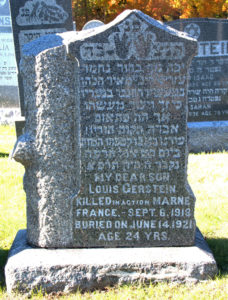 Born in Russia in 1895, Louis was a Private (serial number 1,680,770) in E Company, 307th Infantry Regiment, 77th Infantry Division, and the son of M. Gerstein of 103 Bedford Street in Boston. He was buried – on June 14, 1921 – in Beth Joseph Cemetery #1, at Woburn, Massachusetts (Section 1, Left, Grave 6). This above image of his matzeva is by FindAGrave contributor Joan F. Byington. His name does not appear in Soldiers of the Great War.
Born in Russia in 1895, Louis was a Private (serial number 1,680,770) in E Company, 307th Infantry Regiment, 77th Infantry Division, and the son of M. Gerstein of 103 Bedford Street in Boston. He was buried – on June 14, 1921 – in Beth Joseph Cemetery #1, at Woburn, Massachusetts (Section 1, Left, Grave 6). This above image of his matzeva is by FindAGrave contributor Joan F. Byington. His name does not appear in Soldiers of the Great War.
Thanks to Avi, here is the Hebew text on the matzeva, followed by an English translation:
פנ
תנצבה
יפה נוף בחור נחמד
עזריאל ליב בר מאיר הכהן
במעשיו התגבר בנעריו
כי זך וישר מעשהו
אך הה פתאום
אבדה תקוה הזרי[ח]
עזרנו באבו קטפהו המות
ביום כט אלול תרעה
נקבר ה סיון תרפא
The top two letter acronym stands for “Here is buried”
The second line (with priestly hands in the middle) is an acronym for “May his soul be bound in the bundle of life”. (Based on I Samuel 25:29)
The English translation?
“Handsome in appearance, a pleasant fellow
Azriel Leyb son of Meir the Kohen
In his deeds he excelled in his youth,
for pure and upright were his actions.
But woe! Suddenly
hope was lost! (As) our helper shone,
he was cut in his prime by death
on the 29th of Elul 5675
Buried the 5th of Sivan 5681
The composer of the epitaph had a flair for Hebrew poetry.
Elul having only 29 days, Louis fell in battle the day before Rosh Hashana.
The 6th of Sivan being Shavuot, his burial was the day before Shavuot.
______________________________
Gilbert, Max. – Awarded Distinguished Service Cross. – “At great personal danger while under heavy fire carried a wounded fellow soldier to shelter and administered first aid, thereby saving his life.”
Girier, Morris, 101st Infantry. – Cited for bravery.
Gold, Benjamin, First Sergeant, Company D, 306th Infantry. – On September 7, 1918 while his company was holding a position in the front line, during intense shelling by the enemy, this soldier exhibited high courage, initiative and coolness by taking charge of, controlling and helping care for the wounded, directing them to points of safety, without regard to his own personal danger, until he himself was severely wounded. Cited November 18, 1918.
Goldberg, David A., 103rd Infantry. – Cited for bravery.
Goldstein, Julius, Sergeant, of Philadelphia, Company E, 307th Infantry. – “At Chateau Drable, near Fismes, on August 27, 1918 displayed unusual coolness and great bravery in the face of terrific enemy machine-gun fire. A party from Company E had become lost in the woods and he took out a patrol of four men and led it through the enemy’s lines under terrific fire at all times, found the party, and brought it back to safety around the flank of the enemy’s position.”
Goldstone, Max, Sergeant, Headquarters Company, 397th Infantry. – “For running a line, to Grand Pre in the darkest of nights, through unknown territory under heavy artillery and machine-gun fire. When temporarily stopped by the darkness he stayed with the end of the line and completed it at dawn.” Date, October 15, 1918.
Grossman, A.A., Lieutenant, attached to the 62nd Batallion, Machine Gun Corps. – Won British Military Cross for gallantry and devotion to duty while serving in the fighting at Cambrai.
Hahn, Frederick, Second Lieutenant, Field Artillery. – “Near Cantigny, May 28-30, he unhesitatingly went into heavy shell fire to supervise the repairs of telephone lines and to act as runner when the further maintenance of the wires became an impossibility.” Cited September 6, 1918.
Heineman, Julie, of San Francisco. – Decorated with the Queen Elizabeth Medal by King Albert of Belgium for her work on behalf of French wounded and blind.
Herscovits, Isie J., Color Sergeant, San Francisco. – Cited for valor.
Hirsch, Isaac C., Company E, 306th Infantry. – “On August 27, 1918, voluntarily acted as stretcher bearer, showed great heroism, determination and courage by carrying wounded in an area which was swept by shell, machine-gun and rifle fire.” Cited November 16, 1918.
Hoffman, Edward A., Company H, 306th Infantry. – “Being on duty as observer, remained at his post during violent shell fire on the night of August 27-28, 1918, thus showing great courage and determination.” Cited November 16, 1918.
______________________________
Joseph, S.C., Lieutenant of the Sea Patrol. – Awarded Distinguished Flying Cross for downing eight enemy aircraft.
Now, this is interesting…
Here’s where the AJC made a flat-out error.
Lieutenant S.C. Joseph – Solomon Clifford Joseph – was not a member of the United States Army Air Service, for he was British, and served in Number 210 Squadron of the Royal Air Force. The son of Morris and Jenny Solomon of 14 Spradwell Road in Birmingham, he was an aerial “ace”, attaining 13 aerial victories against the Deutsche Luftstreitkräfte, the air arm of Imperial Germany, two of which were Albatross D.V and five of which were Fokker D.VII fighters.
The following article, from The Jewish Chronicle of September 27, 1918, notes his receipt of the Distinguished Flying Cross.
MILITARY HONOURS
Distinguished Flying Cross
Lieut. S.C. Joseph (Sea Patrol)
A gallant pilot who has accounted for eight enemy aircraft within the past four months. On many occasions the enemy was numerically superior to Lieut. Joseph’s patrol, but this did not prevent his attaining success.
You can read more about his military career in his biography, at The Aerodrome.
______________________________
Kantrowitz, Silas, Albany, N.Y., 104th Infantry – Entire regiment cited.
Kaplan, Jacob, Sergeant, Stokes Mortar Platoon, Headquarters Co., 307th Infantry. – “On October 9, 1918, during the advance in the Argonne Forest, crawled out in advance of the front line to within 100 yards of an enemy machine-gun post, under heavy fire, to observe the effects of our Stokes fire, and did succeed in directing fire so as to cause the enemy machine gunners to withdraw.”
Kauffman, Abraham – “He refused to leave his gun after he had lost a finger during the enemy encounter at Cantigny, May 28, but continued to perform his duty until so severely wounded as to be unable to assist in serving his piece.”
Kessler, Jacob – Cited for bravery in action.
Klick, Albert W., 108th Infantry. – Cited for bravery.
Klosenberg, Samuel, 1560 Southern Boulevard, New York, N.Y. Awarded Distinguished Service Cross.
King, Edward J., 101st Infantry. – Cited for bravery.
Koppel, Harry, of Revere, Mass. – Commended by Secretary Daniels for bravery displayed is rescuing men overboard at sea.
______________________________
Krotoshinky, Abraham. – “Distinguished Service Cross for extraordinary heroism in action in Argonne Forest on October 6. He was on liaison duty with a battalion of the 308th Infantry, which was surrounded by the enemy north of the Forest de la Boironne in Argonne Forest. After patrols and runners had been repeatedly shot down while attempting to carry back word of the battalion’s position and condition, he volunteered for the mission and successfully accomplished it.” Home address, 7 Ritter Place, Bronx, New York City.
This photograph of Private Krotoshinsky appeared in the 1942 edition of The Universal Jewish Encyclopedia, within a section covering Jews in the military. Upon the edge of his left-hand uniform pocket, his DSC is the farthest “left” of the four medals in the image.
Here’s Abraham’s Draft Registration Card, from Ancestry.com (also available through Fold3.com).
And, here’s Abraham’s New York State Abstract of Military Service card, available, as above, through Ancestry.com and Fold3.com.
Here’s a transcript of Abraham’s DSC citation, transmitted from the General Headquarters of the A.E.F., dated November 28, 1918: “Private Abraham Krotoshinsky, Company K, 307 Infantry (AS number 1,706,855) For extraordinary heroim in action in Argonne Forest, France, 6 October 1918. Private Krotoshinsky was on liaison duty with a battalion of the 308 Infantry which was surrounded by the enemy North of the Foret De La Buinonne in Argonne Forest. After patrols and runners had been repeatedly shot down while attempting to carry back word of the Battalion’s position and condition, Private Krotoshinsky volunteered for the mission and successfully accomplished it. Home address: M. Newman, 811 Ritter Place, Bronx, New York City.”
Private Krotoshinsky’s DFC citation was published in The War Record of American Jews, where it’s followed by a transcript of a lengthy New York Times editorial of December 19, 1918, entitled “The Private From the Bronx”.
The military action for which Private Krotoshinky was awarded the DSC – communicating the location and status of the “Lost Battalion” (in reality, two companies of the 306th Machine Gun Battalion, one company of the 307th Infantry Regiment, and six companies of the 308th Infantry Regiment and to American troops, all components of the 77th Infantry Division) to American forces, thus eventuating in the relief and rescue of the “Battalion’s” survivors – was the subject of a 2001 television movie in which Ricky Schroder played the role of Major Charles W. Whittlesey, and Private Krotoshinsky was played by Arthur Kremer. Unsurprisingly and perhaps inevitably – typical to a greater or lesser degree of all “war films” – the movie has a number of historical discrepancies, which are delineated here. Still, I find it rather remarkable that in 2001 a television film was simply made – “period” – about a battle and war with which the overwhelming majority of viewers would have had little to no familiarity.
Even more remarkable is the 1919 70-minute-long silent film production of The Lost Battalion (yes, the same title as the 2001 film) the cast of which included numerous participants of the actual battle, who – well! – played themselves. Thus, Major Whittlesey was played by (then) Colonel Whittlesey, and Private Krotoshinsky was played by – uh – himself. You can read a number of comments about the film, here.
More importantly, you can view the film on YouTube, below.
Private (by then, very much civilian) Krotoshinsky appears – I think – at the 58 minute mark, and most definitely at 4:16, 1:01:15, and 1:05:15.
Other information about the military service and postwar life of Abraham Krotoshinky, which included an effort at aliyah to the Yishuv (from which he’d eventually return to the United States with his wife Abigail and daughters Anna and Judith) is readily available in print and digital format, and might appear in a future blog post.
______________________________
Lederman, Harold P., Second Lieutenant, 30th Infantry, Kansas City, Mo. – Awarded Croix de Guerre for valor at Chetaeu-Thierry.
Leonie, Max, Gardner, Mass., 104th Infantry – Awarded war cross.
Lerner, Philip, Pittsfield, Mass., 104th Infantry. – Entire regiment cited.
Levine, George A., 102nd Machine Gun Battalion. – Cited for bravery.
Levingson, Abe, Private, Company G, 107th Infantry. – Distinguished Service Medal for extraordinary heroism in action near Croix Rouge Farm, northeast of Chateau-Thierry, on July 27.
Levy, Alcan, New York city, 104th Infantry. – Entire regiment cited
Levy, Leon C., Birmingham, Ala. – Awarded Distinguished Service Cross for valor in action at Soissons.
Lewine, Archie. – Awarded Croix de Guerre for extraordinary conscientiousness and remarkable sang froid in performance of his duties during a long and violent gas bombardment.
Lieberman, Nathan, Corporal, Company C., 131st Infantry. – Distinguished Service Cross for extraordinary heroism in action at Chipilly Ridge on August 9. He displayed unusual gallantry in rushing a machine-gun nest whose fire was checking the advance. With the assistance of a man in his squad he put the machine-gun out of action and took four prisoners. Home address, 1426 Birchwood Avenue, Chicago, Ill.
Liner, Irving, Sergeant Major, 308th Infantry. – Awarded Distinguished Service Cross for valor in action.
Linsky, William. – Awarded the Distinguished Service Cross.
Lipsett, Joseph D., 103rd Infantry. – Cited for bravery.
Lipsie, Leo. – Received Croix de Guerre and Distinguished Service Cross.
______________________________
Paralleling the British Jewry Book of Honour’s discrepancy concerning Captain Carl Frederick Falkenberg (mis-spelled as “Falkenburg”) of the Royal Flying Corps, three similar observations can be made for The War Record of American Jews, one example being the entry for Major Kenneth P. Littauer, about whom genealogical information is available through Fold3.com and FindAGrave.
Littauer, K.P., Major, Air Service. – Awarded Distinguished Service Cross for repeated acts of heroism in action near Conflans, on September 14, and near Doulcon, on October 30. He volunteered on a mission to protect a photographic plane for another squadron on September 14 and continued toward the objective at Conflans after three other protecting planes had failed to start. In an encounter with five enemy planes he completely protected the photographic plane by skillful maneuvering, although his observer was wounded and his machine seriously damaged. Home address, Alfred Littauer, father, 100th Street and Fifth Avenue, New York City.
______________________________
So for Colonel Littauer, the same for Lieutenant Roy Luther Manzer, who – in addition – was not an American, having served in the Royal Flying Corps, where he was a 12-victory aerial “ace”.
Manzer, Roy, Lieutenant. – Awarded cross for downing eight hostile aircraft. “Lieutenant Manzer was carrying out a solitary patrol when he observed a two-seater below him. He dived, opening fire, at the same time, and when he had followed the enemy down to a height of 1,000 feet drove it to land outside the airdrome. On his return to our lines he attacked a hostile kite balloon, which, upon reaching earth, burst into flames. Lieutenant Manzer has in addition to these recent victories, downed seven other enemy machines.”
______________________________
Marcus, Herman, of New York. – Cited for bravery in rescuing a drowning child in French port.
Marks, Ben, dispatch rider. – Awarded Cross of Merit by the King of Italy for conspicuous bravery in the Italian theatre of war. Last year the Croix de Guerre with star, was awarded him for gallant and meritorious services on the western front.
Mayer, George B., of Cleveland, O. – An ambulance driver. – Cited in division orders of the French army and awarded the Croix de Guerre with silver star for coolness and bravery on numerous occasions.
Mindheim, Edward N. – An infantryman of New York. Awarded a Distinguished Service Cross for bravery at Chateau-Thierry.
Morton, Samuel J., Sergeant, 132nd Infantry, Prairie Division. – Awarded the Croix de Guerre for bravery.
Moskowitz, Daniel, Company F, 108th Infantry. – “Distinguished Service Cross for extraordinary heroism in action near Ronssoy on September 28. He exhibited exceptional bravery by leaving shelter and going into an open field under heavy machine-gun and shell fire to rescue wounded soldiers.” Home address, 411 Sixteenth Street, Brooklyn.
Muhr, Allen Henry, of Philadelphia. – Awarded War Cross for distinguished service with the American Field Ambulance around Moronvilliers, in Champaigne, northeast of Rheims.
Neuman, Ralph. – Awarded Croix de Guerre for distinguished service and bravery while driving an ambulance.
Ney, Leonard, Harrisburg, Virginia, 104th Infantry. – Entire regiment cited.
Nussbaum, William, 214 East Eighty-second Street, New York City, N.Y., 104th Infantry. Entire regiment cited.
Rafalsky, Nizel, Sergeant, of Baltimore, Md. – Awarded the Distinguished Service War Cross.
Rappaport, Private. – Cited for splendid courage with forces while capturing Argonne Wood and neighboring villages.
Resnick, Mark, Worcester, Mass., 104th Infantry. – Entire regiment cited.
Rose, Maurice, Lieutenant, of Denver. – Officially commended for bravery in action during September and November.
Rosenfeld, Albert, Worcester, Massachusetts, 104th Infantry. – Entire regiment cited.
______________________________
Rosenfeld, Merrill, First Lieutenant, deceased, 115th Infantry. – “Distinguished War Service Cross for extraordinary heroism in action near Verdun. During the various offensives of this regiment in the vicinity of the Meuse River, he displayed the greatest bravery and coolness. He met his death while leading a group that silenced an enemy machine-gun menacing his right flank.” Home address, 2221 Eutaw Place, Baltimore, Md.
Lieutenant Rosenfeld, killed in action on October 16, 1918, served in G Company of the 115th Infantry Regiment, 29th Infantry Division. The son of Israel (1853-10/10/25) and Rebecca (Stern) (1861-12/28/20) Rosenfeld, he was born in Baltimore on May 18, 1883. Buried at Baltimore Hebrew Congregation Cemetery, in Baltimore, Division 3 (Section 10, Lot 130), his name appears in Volume 1 of Soldiers of the Great War.
______________________________
Rosenfield, Harry H., Corporal. – Commended for splendid bravery and coolness. Met his death while keeping telephone lines in continual repair under constant shell fire.
This entry for this man in The War Record of American Jews is ambiguous. I’ve not identified a “Corporal Harry H. Rosenfield”, but there was (?) a Private Harry Rosenfield (146,529) who, while serving in the Headquarters Company, 151st Field Artillery Regiment, 42nd Infantry Division, was killed in action on August 9, 1918. The son of Louis and Sophia Rosenfield, his family resided at 616 James Ave., in Minneapolis. His name appears in Volume 1 of Soldiers of the Great War. His place of burial is unknown.
______________________________
Samuels, Max, Worcester, Massachusetts, 104th Infantry – Entire regiment cited.
Schwartz, Morris C., 3608 Irving Park Boulevard, Chicago, Ill. – Cited by Secretary Daniels for daring accomplishments.
Shapiro, Benjamin, 104th Infantry. – Entire regiment cited.
______________________________
Sharf, Jacob, 82 Malden Street, Everett, Mass., 104th Infantry. – Killed in action March 17, 1918. Entire regiment cited.
______________________________
Shaw, Benedict, New York City, New York, 104th Infantry. – Entire regiment cited.
______________________________
Shefrin, William [Sergeant; 1,701,301] Cook, deceased, Company C, 306th Infantry. – “Distinguished Service Cross for extraordinary heroism in action in the Ravine de L’Homme Mort, near Vauxcere, between the vesle and the Aisne Rivers, September 5, 1918. After both of his feet had been blown off by a bursting shell, Cook Shefrin, although mortally wounded, coolly directed the work of rescuing and saving the other wounded men of the kitchen detachment who had been wounded when his transport was struck.” Cited November 12, 1918.” Home address: 210 Seventeenth Street, Brooklyn, N.Y.
Here is Cook Shefrin’s Abstract Military Service Card (both sides)…
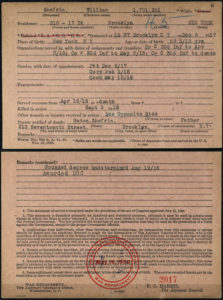 …and here is his photographic portrait, from Soldiers of The Great War (his name appearing on page 345 of Volume 2), by FindAGrave contributor Eric Baker.
…and here is his photographic portrait, from Soldiers of The Great War (his name appearing on page 345 of Volume 2), by FindAGrave contributor Eric Baker.
 The following three images of Cook Shefrin’s matzeva are by FindAGrave contributor S. Daino.
The following three images of Cook Shefrin’s matzeva are by FindAGrave contributor S. Daino.
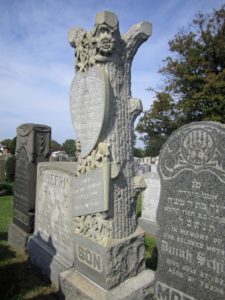
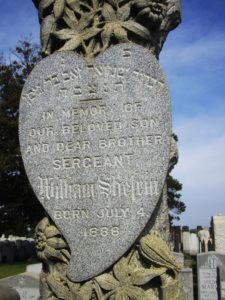
 Cook Shefrin’s Abstract card reveals that he had already been wounded – on August 19 – less than a month before his death in combat on September 5, 1918.
Cook Shefrin’s Abstract card reveals that he had already been wounded – on August 19 – less than a month before his death in combat on September 5, 1918.
Born in New York City on July 4, 1888, he was the son of Naton Shefrin, his family residing at 210 17th Street in Brooklyn. He is buried at the Shifrin Family Plot at Mount Lebanon Cemetery, Glendale, N.Y. (Block U, Section 3, Line 1, Grave 8, in the Shefrin Family Plot)
______________________________
Sidler, Isadore, 101st Infantry. – Cited for bravery.
Silnutzer, Mayer, Corporal, of Philadelphia. – Decorated for bravery by General Pershing. “He was commanding a machine-gun crew in a dangerous position, and it was his gallant conduct which inspired his men to remain at their post. He was wounded in action on July 16, but recovered in the hospital at Viehy, France.”
______________________________
Silverberg, Morris, Private, Company G, 108th Infantry. – “Distinguished Service Cross for extraordinary heroism in action near Ronssoy on September 29. Private Silverberg, a stretcher bearer, displayed extreme courage by repeatedly leaving shelter and advancing over an area swept by machine-gun and shell fire to rescue wounded comrades. Hearing that his company commander had been wounded he voluntarily went forward alone, and upon finding that his officer had been killed brought back his body.” Home address, 800 East Ninety-Ninth Street, New York City.
This portrait of Private Silverberg appears in the 1942 edition of The Universal Jewish Encyclopedia.
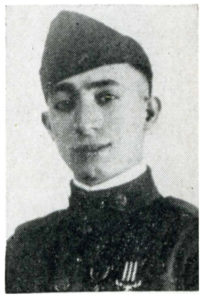 Private Silverberg (2,671,459) was wounded on November 6, five days before the war’s end, but survived. Residing at 309 East 99th Street in Manhattan, he was born in Warsaw in 1896.
Private Silverberg (2,671,459) was wounded on November 6, five days before the war’s end, but survived. Residing at 309 East 99th Street in Manhattan, he was born in Warsaw in 1896.
______________________________
Silverman, Harry, Cambridge, Massachusetts, 104th Infantry. – Gassed. Entire regiment cited.
Simon, Louis C., Jr., Second Lieutenant, 147th Aero Squadron of Columbus, Ohio. – Cited for extraordinary heroism in action in the region of Hadonville Les Lochausse, on September 18.
Simons, Samuel, 6 Day Street, Webster, Mass., 104th Infantry. – Entire regiment cited.
Solomon, David, Sergeant, Company F, 302nd Engineers. – “Cited for gallant conduct in reentering the Ravin Profund, Argonne Forest, in front of the advance elements of our division and in the face of machine-gun and sniper’s fire, to search for Private Seaman, who was found to be missing from the detachment after a skirmish for enemy snipers a few minutes previously. This occurred on September 26, 1918.”
______________________________
Solomon, Nathan, Corporal, 6th Machine Gun Battalion, Marine Corps. – Cited for valor in Battle of the Marne. Killed in action, October 11, 1918.
Born in New York on June 3, 1895, Corporal Solomon, son of Abraham, resided at 1875 Dean Street in Brooklyn. He is buried at Washington Cemetery, in Brooklyn.
______________________________
Sorrow, Louis, Corporal, Company B, 307th Field Signal Battalion. – “Distinguished Service Cross for extraordinary heroism in action near Fleville, between October 13 and 21. After being on duty continuously for thirty-six hours on October 13 he volunteered to repair telephone lines which had been cut by shell fire. Under extremely heavy bombardment he worked all night repairing breaks to lines and thereby making possible constant communication with one of the advanced regiments. On October 21, after one of his helpers had been killed by shell fire, he continued on alone and repaired the telephone lines, displaying unusual bravery and devotion to duty.” Home address: 835 Beck Street, New York.
Spiegel, Frederick. – Awarded War Cross for bravery in the first Piave drive.
Stein, Samuel A., 913 North Marshall Street, Philadelphia, Pa., 104th Infantry. – Entire regiment cited.
Stein, William. – Cited for bravery in action.
Stern, Arthur M., 57 West Eighty-sixth Street, New York. – Awarded the Croix de Guerre for rescuing many wounded during a severe barrage, fire and gas attack.
Stomersky, Isaac, Private, Company B, 306th Infantry. – “On September 6, 1918, while his battalion was advancing to the attack through heavy barrage of high explosives and gas shells, this soldier showed exceptional bravery and devotion to duty as company runner by voluntarily running from place to place in the line, relaying orders and maintaining liaison. He was invariably the first to respond when a runner was needed or when a volunteer was called for to carry a message to the company in front, all of which was beyond his regular duty. During this time he showed the utmost bravery and total disregard to his own personal danger.” – Cited November 16, 1918.
Studinski, Isidore, 104th Infantry. – Entire regiment cited.
______________________________
Swaab, Jacques M., Lieutenant, of New York. – “On September 12, while flying over the battle lines, engaged a German Fokker in combat and dropped it, defeated, to earth. Finding himself approached by a squadron of enemy planes, engaged the first, which met its fate when it fell burning as a result of his gunfire, and then took on one more of these German airships and succeeded in destroying that too, before returning.”
One of the 122 World War One aerial aces of the United States (individuals who specifically served in American – as opposed to British or French – aviation units), Jacques Michael Swaab attained ten confirmed aerial victories against the Germans while assigned to the 22nd Aero Squadron. Akin to Private Abraham Krotoshinsky, information is readily available about him in both digital and print formats, such that “this” post only glancingly scratches the surface – very lightly, at that! – of his story. However, as a general account of his military experiences, here’s his wartime story by Major Falk Harmel, which appeared in the October, 1938 issue of The Jewish Veteran:
A Jewish World War Ace
Introducing Capt. Jacques M. Swaab
In our series of articles on great Jewish military figures we have not dealt with any airmen. This article, reprinted from ‘Post-Scripts,’ which is published by Washington Post No. 58, of which the author is adjutant, introduces us to one of the greatest American wartime aces.
One of the leading “Aces” in American war-time aviation was Captain Jacques M. Swaab, a native of Philadelphia, where he was born on April 21, 1894.
Now in this case the term “Ace,” while retaining the same meaning of superiority as in a card game, was applied during the War to aviators who shot down in aerial combat five or more enemy airplanes. Captain Swaab just doubled the minimum number and ranked sixth among the American “Aces.”
He enlisted in the Aviation Section, Signal Corps, on June 11, 1917 just a year after he graduated from the University of Pennsylvania, where he took a commercial course. During the War, men enlisting for service as flyers were required to go to a ground school for an approximately two months’ course in various subjects with which a flying officer was required to be familiar, and then follow this up with the flying training; so Captain Swaab was sent to the Ohio State University at Columbus, Ohio, for his ground schooling, and graduated in August. He was then sent to Wilbur Wright Field, near Dayton, Ohio, for his flying training. He passed the required test for the flying rating of “Reserve Military Aviator,” and was commissioned a first lieutenant on November 26, 1917. Shortly thereafter he was assigned to duty as Assistant Supply Officer with the 801st Repair Squadron and ordered to France, where he arrived during the latter part of December.
Early in March, 1918, he was transferred to the 3rd Aviation Instruction Center at Issoudun, France, for advanced flying instruction. After completing his training there, he became a test pilot, and in that capacity did remarkable work as a tester of airplanes and as an exhibition flyer. In June, 1918, he was sent to Furbara, Italy, for aerial gunnery training, and on September 1st he joined the 22nd Pursuit Squadron of the 2nd Pursuit Group, which was operating at the front in France. He became deputy flight commander and later flight commander in that Squadron. When the Armistice was signed he was not only the highest ranking “Ace” of the 22nd Squadron, but also of the 2nd Pursuit Group. (A Group consists of three or more squadrons).
Captain Swaab was considered a cool, courageous and able pilot. One officer said of him: “His record of ten German planes in the 65 hours he flew over the lines is probably unexcelled in either the American or Allied Armies.” The Commanding Officer of the 2nd Pursuit Group stated: “Captain Swaab’s career has shown an utter disregard of his own life whenever he could enter in combat with an enemy plane or help a comrade who was hard pressed.”
Captain Swaab, who was promoted to that rank on March 2, 1919, was recommended both for the Medal of Honor and the Distinguished Service Cross for having accomplished the remarkable record of destroying in combat ten enemy planes in a series of six engagements from September 8 to October 31, 1918. These six engagements are summarized below, as follows:
Captain Swaab, on September 8, 1918, exhibited astonishing and consummate gallantry beyond the call of duty in destroying officially three enemy planes while lost in the rear of the German lines from Metz to LaBresse (Vosges). The last of the three he destroyed while wounded and in a fainting condition.
Despite the harrying experience during his second flight over enemy territory, Captain Swaab returned to his duty to participate in the Meuse-Argonne offensive, during which he was consistently loyal and successful in his missions, and in at least one instance he saved the life of a comrade by shooting an enemy plane down from a position favorable for the latter to shoot down the American plane.
On September 8th, Captain Swaab was a member of a voluntary patrol starting from the Toul airdrome to sweep the enemy positions above the region of Pont-a-Mousson. The day was not propitious for a clear view of the territory, and between Pont-a-Mousson and Metz the patrol was split and the various members returned to the airdrome with the exception of Captain Swaab who, for the time losing his bearings owing to his unfamiliarity with the terrain, turned East and went well into the enemy lines and prepared to land at an airdrome in the vicinity of Morhange.
As he was about to descend he observed a German plane rising from the ground. Quickly realizing his predicament, he attacked the enemy and shot down the craft in flames.
Hotly pursued by “flaming onions,” low-angle and anti-aircraft fire, and machine gun bullets, he headed westward, having maneuvered a clear passage. Ten enemy Fokkers appeared in pursuit. Captain Swaab attacked them without further ado, shot one down in flames and received wounds in the top of his head from three machine gun bullets during his flight.
In a fainting condition he continued the attack, with the result that another of the enemy went down out of control. At this stage both of his machine guns became jammed, and he escaped the remaining enemy planes by diving into a cloud bank, coming out some moments later and crashing on a mountainside near LaBresse (Vosges).
Still suffering from his wounds and from injuries sustained in the crash, Captain Swaab resumed active duty at Belrain (Meuse) on September 28th, and in a “dog fight” in the region between Montfaucon and Verdun engaged 12 enemy Fokkers and 3 Rumplers with his eight comrades. In the course of this encounter he was about to go into combat with a picked enemy Pursuit pilot when he observed another of the adversaries pursuing 2nd Lieut. Clinton Jones. With an utter disregard of his own predicament he gave chase to this Fokker plane and, in spite of the fact that two other enemy flyers were firing upon him, he forced Lieut. Jones’ pursuer to withdraw and he then proceeded to destroy it.
On October 23, 1918 in the region of Thenergues, Captain Swaab gave chase to a Fokker which had destroyed one of the American balloons. He brought this plane down in flames. While returning to the American lines from this victorious combat, he attacked an enemy Rumpler plane and, although he was pursued from above by a formation of 12 Fokkers, he succeeded in wounding or killing the observer and destroying the observation plane by causing it to fall out of control, prior to escaping the avenging pursuit of the 12 Fokkers.
On October 27th, Captain Swaab attacked a formation of 7 enemy planes (Fokkers) with 2nd Lt. Clinton Jones and, after having destroyed one of the enemy with Lieut. Jones, he dove to engage an enemy D.F.W. biplane. Despite the fact that he was pursued by another German formation of 9 Fokkers, and with his windshield shattered by machine gun fire, he continued the attack until he had destroyed the enemy D.F.W., which crashed to the ground in a vertical nose dive.
On October 29th, Captain Swaab’s patrol of five was attacked by 8 enemy Fokkers, near Bantheville. Lieut. Beane, leading the patrol, dived into their midst with Captain Swaab and shot down one of the Fokkers, following the defeated enemy pilot to within 50 meters of the ground over enemy soil.
On October 31st, in the region of Triaucourt, Captain Swaab left his patrol, after signaling, in order to attack a fast enemy L.V.G. biplane which was reconnoitering the American lines between the Argonne forest and Verdun. Although forced to follow it for more than 20 miles, climbing from 2,000 to 3,300 meters and being continually exposed to the fire of the enemy observed, he persisted in forcing the issue until his own machine gun caused the enemy plane to explode in mid-air, thus bringing his official victories up to ten.
By General Orders of the War Department, dated 1920, Captain Swaab was awarded the Distinguished Service Cross, the citation therefor covering the aerial combats of September 28th and October 27th, mentioned above.
Here are the two New York State Abstract cards covering Lieutenant Swaab’s military service, photoshopped into a single image.
 Jacques M. Swaab before he was Lieutenant Swaab: His graduation portrait from The Record – the undergraduate student yearbook of the University of Pennsylvania – for the class of 1916…
Jacques M. Swaab before he was Lieutenant Swaab: His graduation portrait from The Record – the undergraduate student yearbook of the University of Pennsylvania – for the class of 1916…
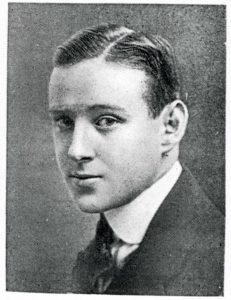 …and somewhat later – after the war? – a portrait of Lieutenant Swaab from World War One Delco.
…and somewhat later – after the war? – a portrait of Lieutenant Swaab from World War One Delco.
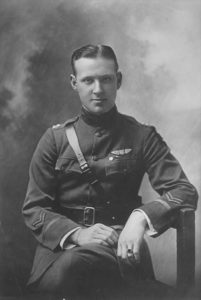 Here’s a list of Lieutenant Swaab’s confirmed aerial victories, from his biographical profile at TheAerodrome. Listed are the date, time of day, and type of enemy plane. While Lieutenant Swaab piloted SPAD XIII aircraft on all these missions, the serial number of the specific SPAD he piloted is known only for the mission of 23 October: S7640.
Here’s a list of Lieutenant Swaab’s confirmed aerial victories, from his biographical profile at TheAerodrome. Listed are the date, time of day, and type of enemy plane. While Lieutenant Swaab piloted SPAD XIII aircraft on all these missions, the serial number of the specific SPAD he piloted is known only for the mission of 23 October: S7640.
1 – 08 Sep 1918 – 1235-1305 – Two-seater, at Cirey-Saarburg
2 – 08 Sep 1918 – 1235-1305 – Fokker D.VII, at Cirey-Saarburg
3 – 08 Sep 1918 – 1235-1305 – Fokker D.VII, at Cirey-Saarburg
4 – 28 Sep 1918 – 0840 – Fokker D.VII, at Ivoiry
5 – 23 Oct 1918 – 1140 – Fokker D.VII, at Thernogues
6 – 23 Oct 1918 – 1210 – Rumpler C, at Thernogues
7 – 27 Oct 1918 – 1540 – Fokker D.VII, at Sommerance
8 – 27 Oct 1918 – 1540 – DFW C, at Champiegneulle
9 – 29 Oct 1918 – 1620 – Fokker D.VII, at Aincreville
10 – 31 Oct 1918 – 1555 – LVG C, east of Verdun
Lt. Swaab’s victories of September 28 and October 29 were shared with Lieutenant James Dudley Beane (six victories; killed in action on October 30), and his DFW victory of October 27 with Lieutenant Clinton L. Jones, Jr., (eight victories) who survived the war.
Notably, various sources relate that the Fokker D.VII shot down by Lieutenant Swaab on 23 October was probably piloted by German 26-victory ace Leutnant Max Näther, who – by that date – had already attained 23 victories against Allied balloons (very dangerous targets; always heavily defended) and aircraft. Näther claimed three more aerial victories on October 29. He died on January 8, 1919.
The painting below by aviation artist Iain Wylie, which appears on the cover of Jon Guttman’s SPAD XII / XIII Aces of World War 1 (Aircraft of the Aces) (Osprey Publishing), depicts Swaab’s victory over Näther, Note that Lieutenant Swaab’s SPAD bears the nickname “Mayer”, after his father.
The caption: “On 23 October 1918, 1 Lt. Jacques Michael Swaab of the 22nd Aero Squadron was conducting a patrol of the front when he spotted a burning Allied balloon. Breaking formation to give chase to the Fokker D VII that had just set the blimp alight, he finally brought his quarry down in flames behind German lines near Thenorgues. His opponent was Leutnant Max Nather of Jagdstaffel 62, who miraculously survived uninjured and added the balloon to his eventual wartime total of 26 victories. While trying to rejoin his formation, Swaab encountered a Rumpler two-seater and shot it down as well, taking his tally to six. The American was flying Kellner-built SPAD XIII S7640, which bore the number “7” and the legend MAYER II under the cockpit, the latter being applied in honour of his father. Swaab’s final score of ten kills made him the “Shooting Star” of the 22nd Aero Squadron.”
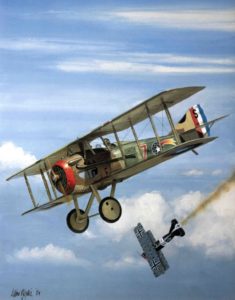 You can view a painting, by Ronny Bar, of Max Näther’s Fokker D.VII at Wingut Wings. Being that the artwork is copyrighted (oh, well…) I’m linking to it here, rather than copying the image into this post. You can see Max Näther in this image (at far left) with fellow Jasta 62 pilots Hans Joachim Hagen and (possibly) Karl Gerster.
You can view a painting, by Ronny Bar, of Max Näther’s Fokker D.VII at Wingut Wings. Being that the artwork is copyrighted (oh, well…) I’m linking to it here, rather than copying the image into this post. You can see Max Näther in this image (at far left) with fellow Jasta 62 pilots Hans Joachim Hagen and (possibly) Karl Gerster.
This other image from World War One Delco shows of one of Jacques’ later SPADs: In this case, serial number S.18869, nicknamed “MAYER III”. The 22nd Aero Squadron’s “shooting star” emblem is surrounded by 10 Balkenkreuz symbols, denoting his aerial victories.
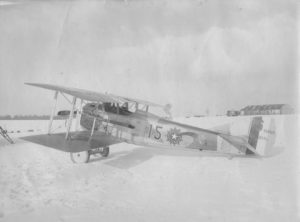 ______________________________
______________________________
Digressing (well, just a little) listed below are the names of four other American Jewish aviators who, as pursuit pilots (when did the specific phrase “fighter pilot” enter the world’s lexicon? – I don’t know!), were casualties during World War One. Two were SPAD XIII pilots, and two (in Royal Air Force service) were S.E.5a pilots.
Brody, Alton Alexander, 1 Lt., United States Army Air Service, 13th Pursuit Squadron
Prisoner of War / Wounded in Action 9/14/18
Combat (with Fokker DVIIs?) at 8:05 A.M.; Shot down by Leutnant Günther von Büren of Jasta 18 while flying SPAD XIII 15145, “12”
Interned at Camp Landshut, Karlsrushe, Germany
Born New York, N.Y., 6/27/96
Student at New York University
Mr. and Mrs. Joseph M. and Rose (Wimpie) Brody (parents)
Mrs. Antoinette (Brody) Marcus (sister)
Mr. Philip M. Brody (brother)
62 West 92nd St., New York, N.Y.
Mrs. Gloria Ann Dworetz (wife), 22 East 89th St., New York, N.Y.
Casualty List 10/23/18
The Evening Telegram (New York) 10/22/18
New York Herald 10/16/18
New York Times 10/16/18, 9/5/30 (marriage), 9/6/40, 9/8/40 (father’s obituary), 10/6/46 (wedding)
The Sky Their Battlefield, pp. 465, 541
Final Report of the U.S. Military Mission on American Prisoners of War – August 10, 1919 – p 58 (Address listed as “6 West 32nd St.”)
The below article about Lt. Brody, found at Fulton History, is from the New York Evening Telegram of October 22, 1918. A transcript follows.

Lt. Brody Held Prisoner in Hun Camp at Karlsruhe
New York Aviator Reported Missing Several Days Ago, Located – Enlisted When College Student
WROTE HOW SHELL BROKE UP SPEECH
Lieutenant Alton Alexander Brody, Thirteenth Aero Squadron, was making a speech before a crowd of American aviators in a little town in France when a German shell fell and stopped the party.
“Oh, dear, it was awfully disconcerting, especially for my speech,” wrote the Lieutenant to Mr. and Mrs. J.M. Brody, of the Brunswick Hotel, at Madison Avenue and Eighty-Sixth Street. That was the last heard of him until he was reported missing in action is the casualty list a few days ago.
In to-day’s list of American prisoners in German prison camp Lieutenant Brody’s name appears again. According to the list he is a prisoner at Karlsruhe.
The New York aviator in his last letter to his mother and father wrote that Lieutenant Charles Biddle, of Philadelphia, was his commanding offider. Brody was taking a course in applied science at New York University when he enlisted in the air service. He has been overseas more than a year.
__________
Rosenbleet, Aaron Maurice, Lt., Royal Air Force, No. 84 Squadron
Prisoner of War 11/10/18
Offensive patrol; left 2:25 P.M.; Shot down west of Marienburg; seen landing under control
Flying S.E.5a F5515
Born Russia, 12/1/96
Mr. Harry Rosenbleet (father), 72 Royalston Ave., North, Minneapolis, Mn.
The Sky Their Battlefield, pp. 455, 564
Simon, Herbert Jerome, 1 Lt., United States Army Air Service, 13th Pursuit Squadron
Killed accidentally 11/14/18 at Louilly, Meuse, France, while flying SPAD XIII
Born San Francisco, Ca., 10/8/95
Mr. and Mrs. Henry and Bertha R. (Limon) Simon (parents), 3020 (3007?) Jackson St., San Francisco, Ca.
Bertram, Godfrey I., J. Sydney, and E.H. Simon (brothers)
Mrs. A. Friedlander and Mrs. Eola (sp?) Berg (sisters)
Buried at San Francisco National Cemetery, San Francisco, Ca. Berkeley Gazette 12/11/18
New York Times 12/29/18
San Diego Union 12/15/18
San Francisco Call 12/11/18
San Francisco Chronicle 12/11/18
“The Great War: A Pictorial History of the 1914-1919 Fight for Freedom” gives date as 10/14/18
Other sources give date as 11/14/18
Winkler, Moses Harry, Lt., Royal Air Force, No. 56 Squadron
Prisoner of War 10/21/18
Low bombing patrol; last seen out of control 12 miles east of Le Cateau at 3:00 P.M., while flying S.E.5a F5463
Interned at Camp Villingen, Karlsrushe, Germany
Born Meridian, Ms., 1/12/96
119 South 12th St., Baton Rouge, La. (11-12-39) / Box 114, Meridian, Ms.
Casualty List 11/27/18
Final Report of the U.S. Military Mission on American Prisoners of War – August 10, 1919 – p 584 (gives name as “Moses”)
The Sky Their Battlefield, p. 441, 572
British Jewry Book of Honour, p. 536
______________________________
Teitelbaum, Bernard, Private, Sanitary Detachment, 306th Infantry,. – “This soldier, with extraordinary heroism and devotion to duty, continued to give first aid to five wounded men under severe shell fire of shrapnel and high explosives, to the utter disregard of his own personal danger, until he was himself hit by shrapnel and severely wounded. At the time he was attached to the Third and Fourth Platoons, Company D, 306th Infantry, holding a position in the front line.” Cited November 16, 1918.
Toelken, Julius W., Second Lieutenant, 104th Infantry. – “Distinguished Service Cross for extraordinary heroism in action near Douresches, France, July 20, 1918. When the advance of his platoon was checked by enemy machine-gun fire Lieutenant Toelken crawled forward alone to a position from which he could fire, and killed three of the machine-gun crew, after which, with his platoon, he captured the gun and turned it on the foe.” Home address, 145 Union Street, Springfield, Mass. Cited November 12, 1918.
Weichmann, Walter, 103rd Infantry. – Cited for bravery.
Westzenberg, George, Sergeant, of the Medical Detachment, Company A, 2nd Anti-Aircraft Machine Gun Battalion. – Cited for bravery in action at Neuvilly. “He voluntarily ran through enemy shell-fire to aid two soldiers who had been wounded. He found one dead but administered anaesthetics to the living and remained with him till an ambulance came to the scene”
Wetzler, Albert E., 101st Infantry. – Cited for bravery.
Wise, Henry E., Lieutenant, an American Red Cross canteen officer, of Long Branch, N.J. – Cited a second time for the French Red Cross.
______________________________
Wise, Sol., Lieutenant, of Cincinnati. – Was awarded the Croix de Guerre for sending down a Boche flyer on August 11.
You can read much more about Lieutenant Wise in my blog posts Flight in The Great War: Lieutenant Sol Wise, Aerial Observer, Armée de l’air – I: A Letter Home, and, Lieutenant Sol Wise, Aerial Observer, Armée de l’air – II: Biography, Briefly.
______________________________
Zion, Peter P., Lieutenant, of New York City. – Awarded the Distinguished Service Cross and recommended for promotion to captain. “Though his arm was badly slashed by a German sword bayonet, he refused to go to a dressing station, but remained in command of his platoon until the day’s objective had been obtained.”
In conclusion, it has become apparent from the information now available that the record of Jewish War Service, when fully developed, will demonstrate incontestably that the Jews of America have contributed their full quota to the winning of the war, and a generous margin beyond their quota; that they have enlisted cheerfully, fought gallantly and died bravely for the United States. Those who knew the quality of Jewish loyalty needed no proof of this. They knew that the qualities which had enabled the Jew to survive through the centuries – his capacity to endure, without breaking, prolonged and intense nerve strain; his qualities of initiative, his elasticity of mind, his capacity for organization, and above all, his idealism – would enable him to fit himself successfully into a democratic army fighting for world democracy. In this they have not been disappointed. But to communicate this knowledge to the outside world it becomes necessary to establish the known facts on the soundest possible foundations. This the present record promises to accomplish.
______________________________
______________________________
Next, The War Record of American Jews during the “next” war: The Second World War.
Readings, References, Writings and What-Not
Books
Adler, Michael, and Freeman, Max R.G., British Jewry Book of Honour, Caxton Publishing Company, London, England, 1922 (Republished in 2006 by Naval & Military Press, Uckfield, East Sussex)
Franks, Norman, Bailey, Frank, and Duiven, Rick, Casualties of the German Air Service – 1914-1920, Grub Street, London, 1999
Guttman, SPAD XII / XIII Aces of World War 1 (Aircraft of the Aces), Osprey Publishing, Oxford, England, 2002
Haulsee, William Mitchell; Howe, Frank George; Doyle, Alfred Cyril, Soldiers of the Great War – Memorial Edition: Volume I (Alabama through Maryland), Washington, D.C., Soldiers Record Publishing Association, 1920
Haulsee, William Mitchell; Howe, Frank George; Doyle, Alfred Cyril, Soldiers of the Great War – Memorial Edition: Volume II (Massachusetts through Ohio), Washington, D.C., Soldiers Record Publishing Association, 1920
Haulsee, William Mitchell; Howe, Frank George; Doyle, Alfred Cyril, Soldiers of the Great War – Memorial Edition: Volume III (Oklahoma through Wyoming), Washington, D.C., Soldiers Record Publishing Association, 1920
Henshaw, Trevor, The Sky Their Battlefield – Air Fighting and The Complete List of Allied Air Casulties from Enemy Action in the First War, Grub Street, London, 1995
The War Record of American Jews – First Report of The Office of War Records, American Jewish Committee, January 1, 1919, The American Jewish Committee, New York, N.Y., 1919
Periodicals
Harmel, Folk, A Jewish World War Ace, The Jewish Veteran, October, 1938, p. 13
Other Publications
The Universal Jewish Encyclopedia, New York, N.Y., 1942
Websites
Guide to the Records of the American Jewish Committee – Office of Jewish War Records, undated, 1918-1921, 1962, processed by David Solomon, at Center for Jewish History
Simon L. Bloch Cohen (“A Story about the Horrors of War”), at Brotman Blog
Solomon Clifford Joseph, at The Aerodrome
Roy Manzer, at The Aerodrome
Max Näther, at The Aerodrome
Max Näther, at Wikipedia
Jacques Michael Swaab, at The Aerodrome
Iain Wyllie‘s painting of Jacques Swaab shooting down Max Nather, as featured on cover of SPAD XII / XIII Aces of World War 1, at Pinterest
SPAD S.XIII “15” (“MAYER III”) Number S.18869 of 22nd Aero Squadron, assigned to Lieutenant Jacques M. Swaab, France, Winter of 1918-19, from Gary L. Smith Collection, at 1000 Aircraft Photos.com
Max Näther’s Fokker D.VII (OAW) 6441 / 18, of Jasta 62, by Ronny Bar, at Wingnut Wings

